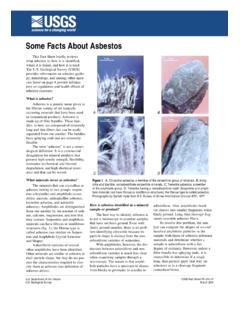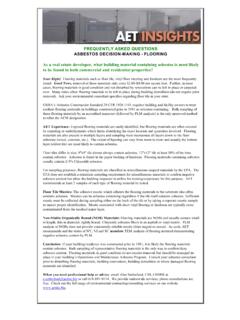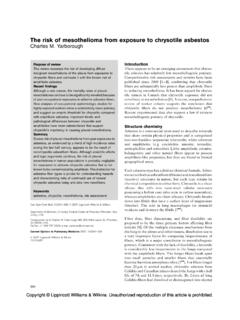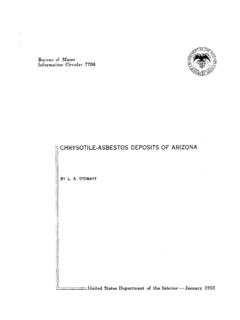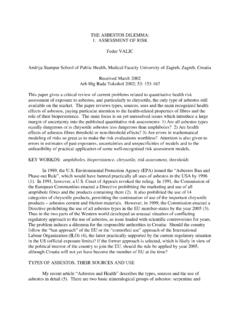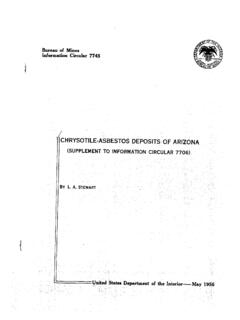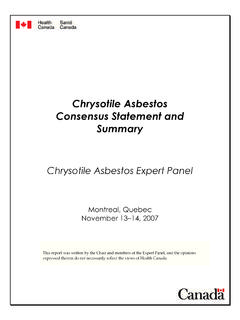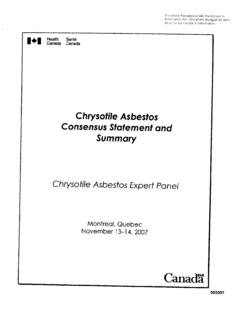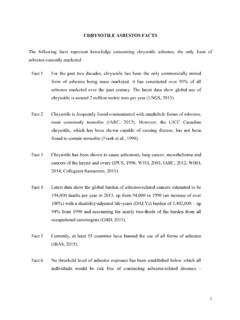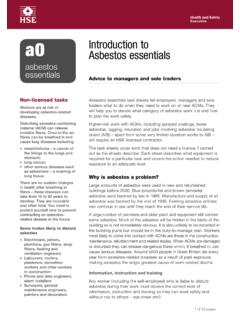Transcription of CHARACTERIZATION OF CHRYSOTILE, ANTIGORITE AND …
1 883 The Canadian MineralogistVol. 41, pp. 883-890 (2003) CHARACTERIZATION OF chrysotile , ANTIGORITEAND LIZARDITE BY FT-RAMAN SPECTROSCOPYCATERINA RINAUDO AND DANIELA GASTALDID ipartimento di Scienze e Tecnologie Avanzate, Universit del Piemonte Orientale Amedeo Avogadro ,Corso Borsalino 54, I 15100 Alessandria, ItalyELENA BELLUSOD ipartimento di Scienze Mineralogiche e Petrologiche, Universit di Torino, Via Valperga Caluso 35, I 10125 Torino, ItalyABSTRACTWe analyzed samples of ANTIGORITE , lizardite and fibrous chrysotile , three representative minerals of the serpentine group, todetermine their chemical and structural properties, and their FT-Raman spectra. The low-frequency region of the spectrum (1200 200 cm 1), which corresponds to the lattice-vibration modes, was then analyzed, and the observed bands attributed, on the basisof our results. Raman spectroscopy thus proves useful in identifying the three mineral species, despite their strong similarities instructure and chemical composition.
2 The symmetric stretching modes of the Si Ob Si linkages vibrate at different frequencies inchrysotile and ANTIGORITE , whereas chrysotile and lizardite can easily be identified by analyzing the vibrations of the OH Mg OHgroups and the bands in the range 550 500 cm : Raman spectroscopy, asbestos , serpentine-group minerals, chrysotile , ANTIGORITE , avons analys des chantillons d ANTIGORITE , de lizardite et de chrysotile fibreuse, trois min raux repr sentatifs du groupede la serpentine, afin d en d terminer les propri t s chimiques et structurales, et leurs spectres de Raman avec transformation deFourier. La r gion du spectre faible fr quence (1200 200 cm 1), qui correspond aux modes de vibration du r seau, a t analys e, et les bandes observ es ont t attribu es. Les spectres s av rent ainsi utiles dans l identification des trois esp ces,malgr leurs grandes ressemblances structurales et compositionnelles.
3 Les modes d tirement sym triques des agencementsSi Ob Si vibrent des fr quences diff rentes dans le chrysotile et l ANTIGORITE , tandis que chrysotile et lizardite sont facilementidentifiables par analyse des vibrations des groupes OH Mg OH et des bandes dans l intervalle 550 500 cm 1.(Traduit par la R daction)Mots-cl s: spectroscopie de Raman, min raux asbestiformes, min raux du groupe de la serpentine, chrysotile , ANTIGORITE , lizardite. E-mail address: three principal minerals of the serpentine group, chrysotile , ANTIGORITE and lizardite, have a very similarchemical composition, but significantly different struc-tures. In fact, the single ideal chemical formula(OH)3Mg3[Si2O5(OH)] corresponds to several crystalstructures that represent different solutions for the mini-mization of the mismatch between sheets of SiO4 tetra-hedra and sheets of MgO2(OH)4 octahedra.
4 In lizardite,the resulting structure is planar, owing to shifts of theoctahedral and tetrahedral cations away from their idealpositions and to the limited Al-for-Si substitution in thetetrahedral sites. In ANTIGORITE , the misfit is compensatedby an alternating-wave structure in which the sheet ofoctahedra is continuous, whereas the SiO4 tetrahedra aretilted and periodically switch their orientation, pointingalternatively in opposite directions. Finally, chrysotilehas a coiled structure, which is responsible for its prop-erties as asbestos (Wicks & Whittaker 1975, Wicks &O Hanley 1988, Veblen & Wylie 1993).884 THE CANADIAN MINERALOGISTN aturally occurring intergrowths of three types ofserpentine minerals are very common. It is thus of greatinterest to find an experimental technique that permitsidentification of the mineral species without long andcostly preparation of the sample.
5 Raman spectroscopyfits these criteria: it is a simple and rapid technique, andnecessitates no sample preparation. It has been usedsuccessfully by a number of investigators in the studyof chrysotile (Lewis et al. 1996, Bard et al. 1997,Kloprogge et al. 1999), but only one bibliographic ref-erence has been found concerning its use in the identifi-cation of ANTIGORITE and lizardite (Pasteris & Wopenka1987). In this latter work, no attribution for the bands ismade to the vibrational modes of the groups constitut-ing the crystal order to identify the Raman vibrations that arespecific to each serpentine phase studied and that wouldpermit rapid recognition of the mineral, several speci-mens of the three species were examined. Beforecharacterization by Raman spectroscopy, the crystallo-graphic and chemical properties of each sample wereestablished using the techniques of X-ray powder dif-fraction (XRD), scanning electron microscopy (SEM),transmission electron microscopy (TEM), analyticalelectron microscopy (AEM), and energy-dispersionspectrometry (EDS).
6 EXPERIMENTALSome of the samples of chrysotile studied were pro-vided by NIST (National Institute of Standards andTechnology). Others were taken from the reference col-lections of the Dipartimento di Scienze Mineralogichee Petrologiche, Universit di Torino, and are found inoutcrops of rocks rich in serpentine minerals in the Pied-mont Alps, of the samples of ANTIGORITE studied were takenfrom the Dipartimento di Scienze Mineralogiche ePetrologiche, Torino, and come from the same areasmentioned sample of lizardite in the study comes fromMonte Fico, Elba Island, Italy; its structural and chemi-cal properties were studied previously by Mellini & Viti(1994), and the sample was kindly provided by Profes-sor the XRD analyses, the samples were powderedin an agate mortar. No problems were encountered withthe ANTIGORITE or lizardite, but chrysotile fibers neededto be cut with scissors before crushing, as they are soflexible and powdered sample was mounted on a flat holderand examined initially by the powder method using aSiemens D5000 X-ray diffractometer equipped withCuK radiation.
7 The EVA software program was usedto determine the mineral phases present in each X-raypowder spectrum, by comparing the experimental peakswith PDF2 reference the XRD spectra are very similar for mineralswith such similar chemical and crystallographic prop-erties, more precise CHARACTERIZATION of each sample wasperformed by transmission electron microscopy (PhilipsCM12 instrument, operated at 120 kV); they werechemically analyzed with the attached EDS microprobe[EDAX Si(Li) detector PV9800]. The standardlessSUPQ program was used with the default K factors toprocess the chemical data; the final values were obtainedas normalized proportion of oxides ( ). The sampleswere prepared by suspending the powder in isopropylalcohol, and the suspension then underwent ultrasoundtreatment in order to minimize fiber aggregation; finally,several drops of the suspension were deposited on acarbon-supported Cu percentage of each mineralogical phase detectedin the XRD spectrum was easily calculated using theEVA support program, which compares the area andintensity of two diffraction peaks, each diagnostic of onemineral component of the mixture.
8 It is worth notingthat the calculated values are reliable in powdered speci-mens without preferred orientation of the componentcrystallites. In our case, especially for chrysotile , somepreferred orientation of the fibers certainly was percentages calculated on the basis of the XRDspectra were therefore compared with the data obtainedusing TEM and AEM. In this case, selected-area elec-tron diffraction (SAED) patterns and EDS TEM chemi-cal analyses of each point examined permittedconclusive attribution to the mineral phase. Many crys-tals and different points within a single bundle of fibersfrom each specimen of chrysotile and ANTIGORITE wereanalyzed by SAED and EDS TEM. Thus it was pos-sible to calculate the proportion of each coexistingmineral morphological study was performed with a Cam-bridge Stereoscan 360 SEM: the samples were gluedonto aluminum stubs with colloidal graphite and thencoated with a carbon film approximately 400 in , the serpentine phases were studied in a back-scattering geometry with a Bruker RFS100 FT-Ramanspectrometer equipped with an Nd:YAG laser at an ex-citation wavelength of 1064 nm, and a Ge detector,which requires liquid N2 for cooling.
9 The advantage inusing a laser operating at near-infrared radiation is thatthe fluorescence from the sample is reduced, heating andphase transition are avoided, and measurements aremade possible for longer periods of time. All the spec-tra of each mineral were recorded on several mg of pow-dered sample. Random orientation of the crystallites inthe powder analyzed was achieved only with theantigorite and lizardite samples; in the case of chryso-tile, some preferred orientation of the fibrils is impos-sible to avoid. The Raman spectra were obtained at a2cm 1 resolution and by adapting the laser power andnumber of scans in order to optimize the signal-to-noiseFT-RAMAN SPECTROSCOPY OF chrysotile , ANTIGORITE AND LIZARDITE885ratio: 2000 scans over 100 minutes and 120 mW weresufficient in order to obtain the optimum calibration of the Raman spectrometer wasassured by a reference He Ne laser ( nm).
10 Theaccuracy of the band position was also checked by mea-suring the center wavenumber of two Stokes and anti-Stokes bands at low frequencies: if everything iscorrectly calibrated, they are this work, only the Raman region related to lat-tice-vibrational modes ranging from 1200 to 200 cm 1was AND DISCUSSIONThe three species of serpentine considered in thiswork are commonly found in a single specimen; severalsamples were tested, especially for chrysotile andantigorite. The samples selected for Raman spectros-copy satisfied the criterion of having one largely pre-dominant phase, as revealed by XRD, TEM and AEMstudies. The chrysotile , ANTIGORITE and lizardite speci-mens selected showed the presence of other phases aswell, but in minor chrysotile sample chosen accounts for about95%, and ANTIGORITE , for about 5% of the whole chemical composition of the chrysotile fibers in thesample studied was established by several analyses per-formed under TEM by AEM on the selected areas, andproved to be: ( ) ( ) (OH) and TEM analyses of the ANTIGORITE samplechosen for Raman CHARACTERIZATION revealed an almostpure ANTIGORITE ; no more than 3% of chrysotile wasfound to be present.
